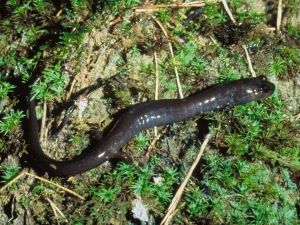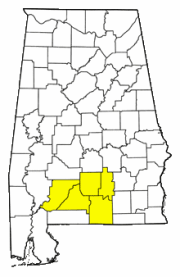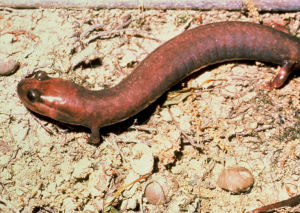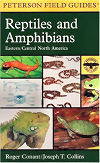
HOME
INTRO
SYMBOLS
ALMANAC
ECONOMY
GEOGRAPHY
STATE MAPS
PEOPLE
GOVERNMENT
FORUM
NEWS
COOL SCHOOLS
STATE QUIZ
STATE LINKS
BOOK STORE
MARKETPLACE
GUESTBOOK
CONTACT US


You may double left-click on a word on this page to retrieve its definition. Tweet Follow
Alabama State Amphibian

State Amphibian: Red Hills salamander
Photograph: Emmett Blankenship, U.S. Fish & Wildlife Service
Senate Bill No. 147, proposing the Red Hills salamander (Phaeognathus hubrichti) as official state salamander, was introduced to the Alabama State Senate on February 1, 2000 during the Regular Session of the Alabama Legislature. It was read for the first time and referred to the Senate committee on Agriculture & Forestry.
On February 15, 2000, the measure was read for the third time in the Senate and approved. 48 Senators voted in favor of the Red Hills salamander as a representative of the State of Alabama.
Forwarded to the House of Representatives for their consideration, Senate Bill No. 147 was read and forwarded to the House committee on Agriculture, Forestry & Natural Resources. After two weeks in committee, the bill was read for the second time and then placed on hold for a month. On April 6, Senate Bill No. 147 was approved by the Alabama House of Representatives.
SB147
By Senators Lipscomb, Butler, Armistead, Myers, Callahan, Lee, Dixon, Bedford, Little (Z), Denton, Holley, Mitchell, Lindsey, and Preuitt
An Act, To designate the Red Hills Salamander as the official state amphibian.
Under existing law, the State of Alabama does not have an official state amphibian. This bill would designate the Red Hills Salamander as the official state amphibian.
BE IT ENACTED BY THE LEGISLATURE OF ALABAMA:
Section 1. The Red Hills Salamander, Phaeognathus hubrichti Highton 1961, is hereby designated and named as the official state amphibian of Alabama.
Section 2. This act shall become effective immediately following its passage and approval by the Governor, or its otherwise becoming law.
Alabama's Governor Don Siegelman signed the legislation on April 13, 2000. Act 232 of the 2000 Alabama Legislature designated the Red Hills salamander the official state amphibian of Alabama.
About the Red Hills Salamander

State Amphibian: Red Hills salamander
Photograph: © Dave Dennis, used with permission
Before 1960, the Red Hills Salamander was unknown... at least, to scientists. It was discovered by land snail expert, Leslie Hubricht, in Butler County in 1960. He was searching for snails. Instead, he found a large brown salamander. It was later determined by Dr. Richard Highton of the University of Maryland that this salamander was a new species, the first discovered in over 60 years. Dr. Highton named the salamander Phaeognathus hubrichti in 1961. Phaeognathus means "dark jawed" and hubrichti is given to honor the salamander's discoverer, Leslie Hubricht.
A second Red Hills Salamander was obtained by an Ohio State University team in 1963. They discovered that the salamanders lived in burrows on the slopes of moist, cool ravines shaded by hardwood trees. They like moist conditions. Because they remain in their borrows during the day, the best time to spot a salamander is at night when they come out to eat. Searching for their borrows at night with flashlights is generally productive.
Relatively large for salamanders, Red Hills Salamanders can grow to become 10 inches long. Their bodies are dark brownish-purplish with lighter sides and no obvious markings.

Range by county
Courtesy: Auburn University
Red Hills Salamanders are found only in Alabama and only in an area of about 50-60,000 acres in a 60-mile narrow belt between the Conecuh and Alabama rivers. Residing in two siltstone geological formations, the Tallahatta and Hatchitigbee, they are found only in parts of Butler, Crenshaw, Conecuh, Covington and Monroe Counties.
Because the Red Hills Salamander lives in a very small section of Alabama, and the world for that matter, and because of the loss of habitat and low reproductive rates, it was placed under Federal protection in 1976. Under the endangered species act, the United States Fish and Wildlife Service listed the Red Hills Salamander as "threatened". Threatened means that the species is likely to become endangered if it is not protected. An "endangered" species is one that is in immediate danger of becoming extinct and needs protection to survive.
It's estimated that about 60 percent of the remaining salamander habitat is currently owned or leased by paper companies, which use clear-cut systems of forest management. Clear-cutting, along with mechanical site preparation for replanting, appears to completely destroy the habitat for the Red Hills salamander.
Recommendations of U.S. Fish and Wildlife Service
- Clear cutting should be avoided on slopes containing Red Hills salamander burrows, especially on the steeper slopes.
- Mechanical site preparation should be avoided. This practice destroys burrows and exposes the soil to desiccation.
- Woody litter should be maintained to provide shade and maintain the moisture content of the soil. In addition, woody litter is important for the preservation of the microarthropod prey community and for nutrient conservation.
- Selective cutting may not adversely impact salamander population if carried out in such a manner to minimize surface disturbance to the upper and middle sections of the slopes where most salamander burrows are found. In any case, a tree canopy providing over a two-thirds shade cover is recommended.
- When cutting areas above or below a slope that contain Red Hills salamander burrows, a buffer area should be left. If this buffer is excluded, the sun will dry out the soil surface despite the presence of vegetation on the slope. The necessary size of the buffer will vary depending on sun angle and slope orientation, but it should provide sufficient shade at all times a day.
- Chemical sprays having adverse effects on amphibians, their eggs, or the salamander's invertebrate prey should be avoided.
Alabama Law
The following information was excerpted from the Code of Alabama, Title 1, Chapter 2.
Title 1.
CHAPTER 1-2. STATE SYMBOLS AND HONORS.
SECTION 1-2-34. STATE AMPHIBIAN.
State amphibian.
The Red Hills Salamander, Phaeognathus hubrichti Highton 1961, is hereby designated and named as the official state amphibian of Alabama.
(Act 2000-232, p. 367, §1.)
Sources...
"Red Hills salamander." U.S. Fish & Wildlife Service: Division of Endangered Species. 2004. 15 December 2004
"Red Hills salamander." Alabama Forestry Commission. 2004. 15 December 2004
Auburn University: Private Forest Management Team. 2004. 15 December 2004
"Bill Status for SB147 Regular Session 2000." Alabama Legislative Information System Online. State of Alabama, 11 Apr 2000. Web. 15 December 2004.
"Chapter 2 STATE SYMBOLS AND HONORS.." The Code of Alabama 1975. State of Alabama. Web. 14 December 2004.
Shearer, Benjamin F. and Barbara S. State Names, Seals, Flags and Symbols: A Historical Guide Third Edition, Revised and Expanded. Westport, Conn: Greenwood Press, 3 Sub edition, 2001.
Additional Information

State Amphibian: Red Hills salamander
Photograph: C.K. Dodd, Jr., U.S. Fish & Wildlife Service
State Amphibian: Alabama Department of Archives and History.
The Red Hills Salamander: Evolutionarily distinct and globally endangered
Phaeognathus hubrichti: University of Michigan Museum of Zoology: Animal Diversity Web.
Red Hills Salamander :
U.S. Fish and Wildlife Service Fact Sheet.
:
U.S. Fish and Wildlife Service Fact Sheet.
Phaeognathus hubrichti: Encyclopedia of Life.
Red Hills Salamander: The Zoological Society of London, Evolutionarily Distinct and Globally Endangered (EDGE) species.
State amphibians: Complete list of official state amphibians.
More symbols & emblems: Complete list of official Alabama state symbols from NETSTATE.COM.
Salamanders of the United States and Canada: by James W. Petranka. 587 pages. Smithsonian; 1 edition (July 17, 1998) This survey of North American salamanders is the first since the 1940s and presents the most up-to-date research on every species. Beginning with two keys to help the reader identify an animal in the hand, whether it is an adult or a larva ("tadpole"), the book then discusses each species individually.
Newts and Salamanders: Everything About Selection, Care, Nutrition, Diseases, Breeding, and Behavior by Frank Indiviglio. 96 pages. Barron's Educational Series (June 1, 1997) Terrarium enthusiasts will find up-to-date information and full-color photos describing the major native and exotic species of newts and salamanders. The author gives advice on feeding and keeping them in a healthful environment. Topics include creating the various types of habitats, nutrition, reproduction, the treatment of diseases, and sources of food and supplies.
What is an Amphibian? (The Science of Living Things) , by Bobbie Kalman and Jacqueline Langille, 32 pages, Crabtree Publishing Company (2000). Reading level: Ages 9-12. The large, full-color photographs and illustrations that pepper every page of these books will catch the eye of browsers but it is the informative, easy-to-read texts that will hold their interest.
Peterson First Guide to Reptiles and Amphibians , by Robert C. Stebbins, Joseph T. Collins and Roger Conant. Edited by Roger Tory Peterson. 128 pages, Houghton Mifflin Harcourt (April 15, 1999). From mudpuppies to rattlesnakes, this fascinating guide for young nature lovers describes the habits and habitats of these secretive and sometimes bizarre animals, and includes tips on how to catch and care for frogs, snakes, turtles, lizards, salamanders, and toads.

A Field Guide to Reptiles & Amphibians of Eastern & Central North America, by Roger Conant and Joseph T. Collins, 640 pages, Houghton Mifflin Harcourt; Fourth Edition edition (May 15, 1998). This newly designed field guides features detailed descriptions of 595 species and subspecies. The 656 full-color illustrations and 384 drawings show key details for accurate identification. More than 100 color photographs and 333 color photographs and 333 color distribution maps accompany the species descriptions.
Firefly Encyclopedia of Reptiles and Amphibians, edited by Tim Halliday and Kraig Adler, 240 pages, Firefly Books (September 7, 2002). With lush color photographs and lavishly detailed illustrations, this encyclopedia presents a striking abundance of information at a glance. Also noteworthy is the scholarly text, a comprehensive overview of these frequently studied phyla.
Reptiles & Amphibians for Dummies, by Patricia Bartlett, 360 pages, For Dummies; 1st edition (June 1, 2003) This essential guide tells you what you must know before you own a reptile or amphibian, with authoritative advice on everything from proper caging and feeding to health care, socializing, transporting, and more. You'll find out about the different species, normal and abnormal behavior, the basics of breeding, and complying with laws.

